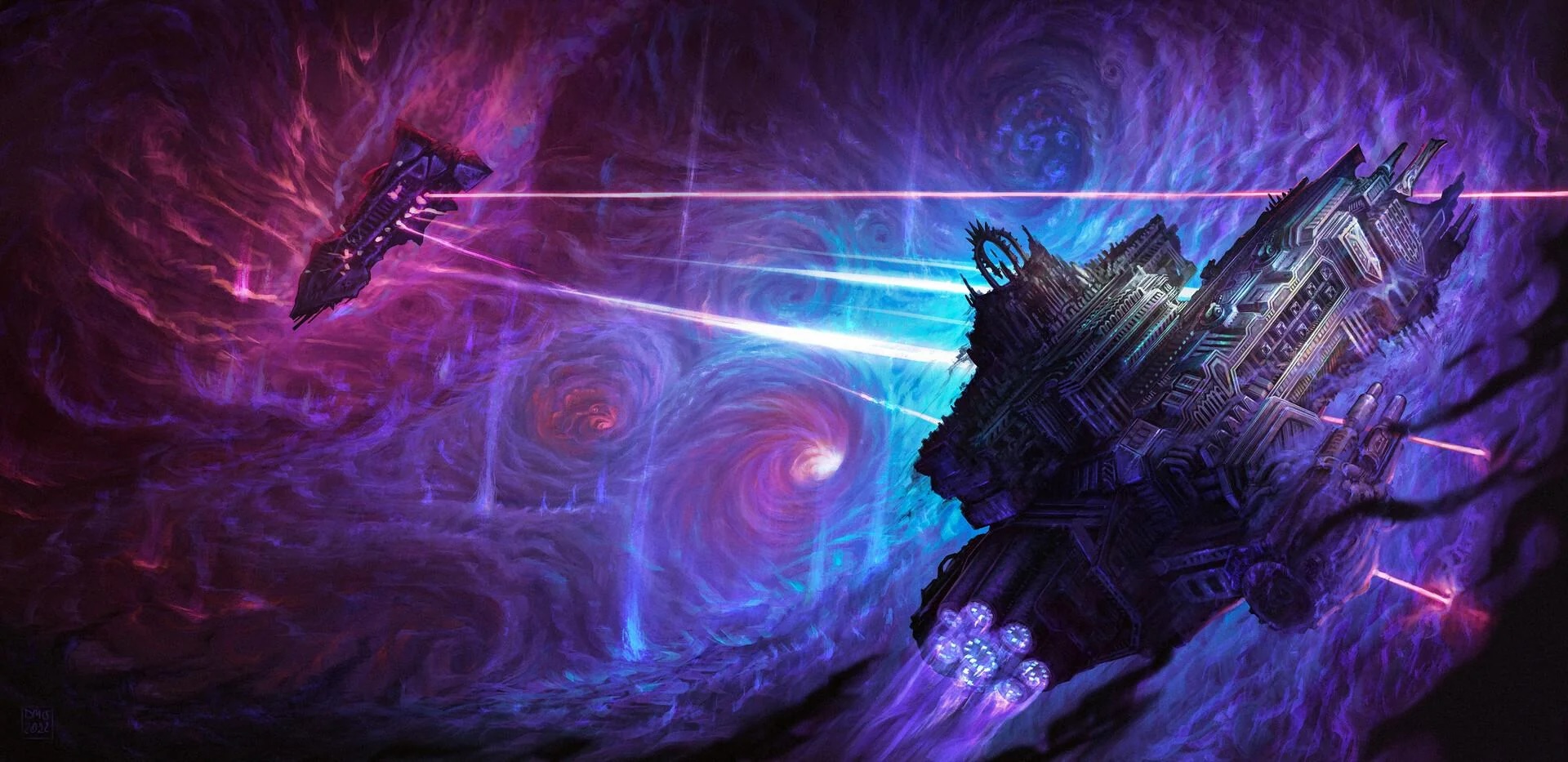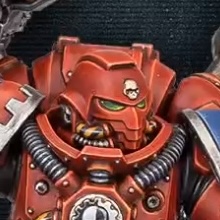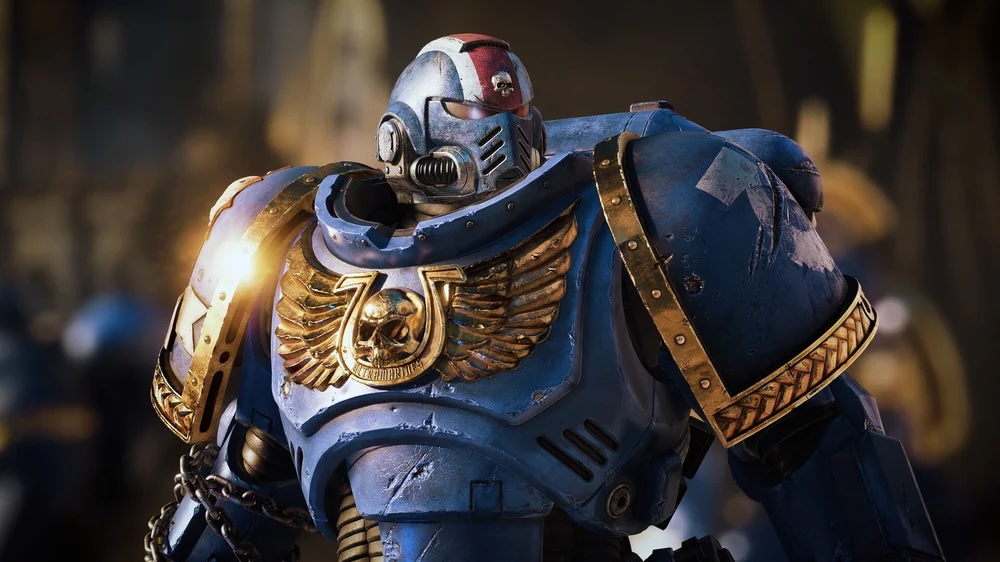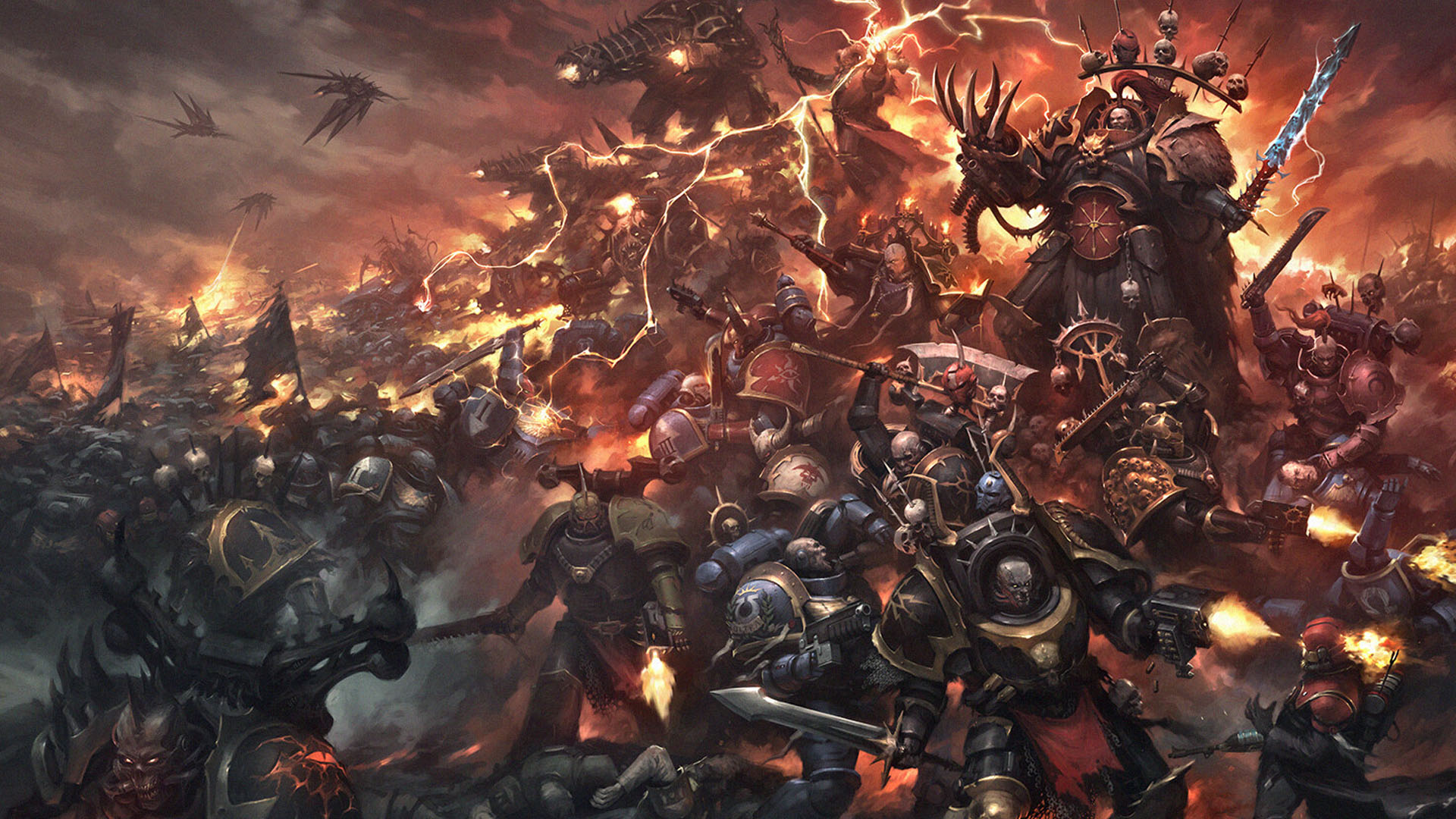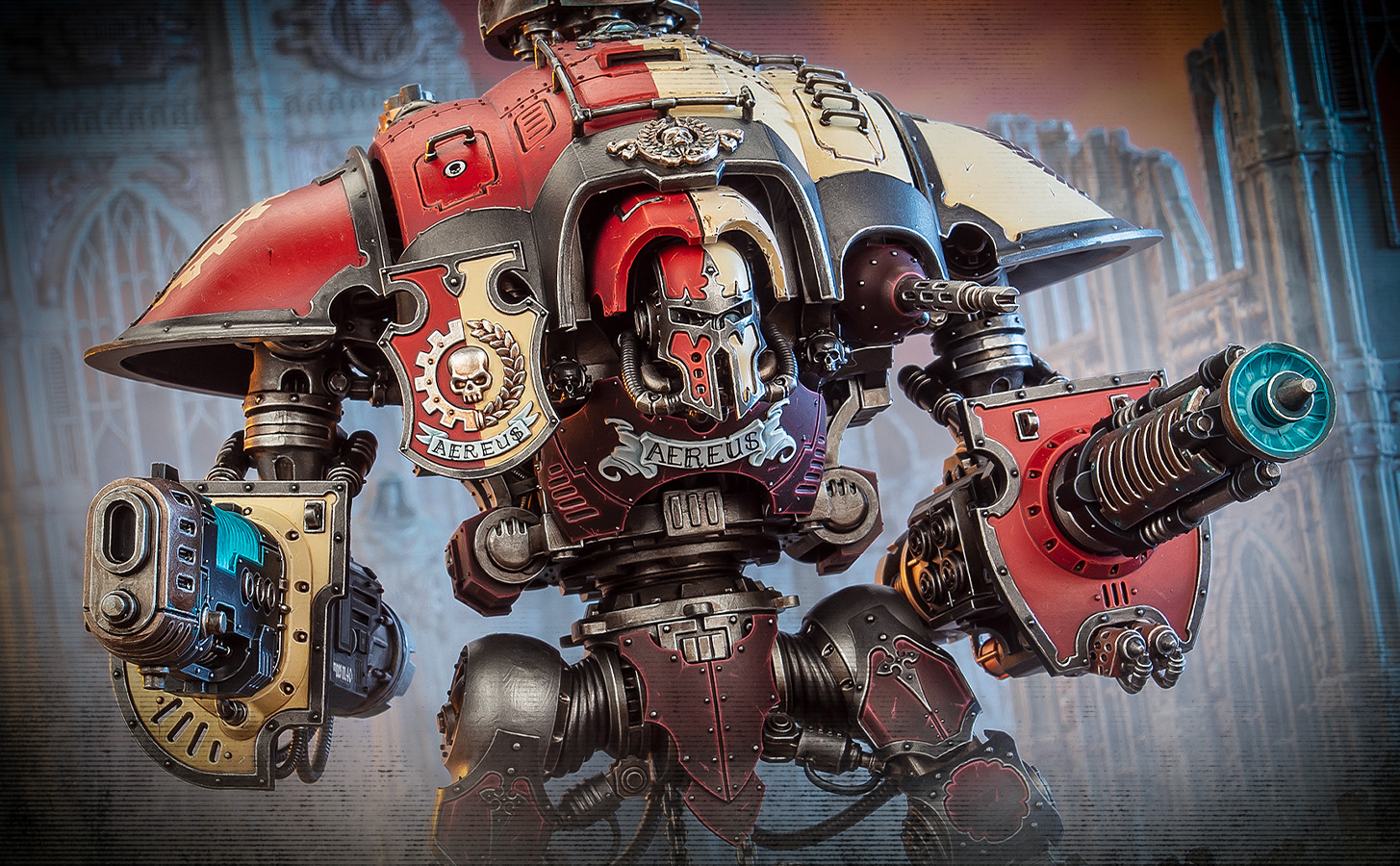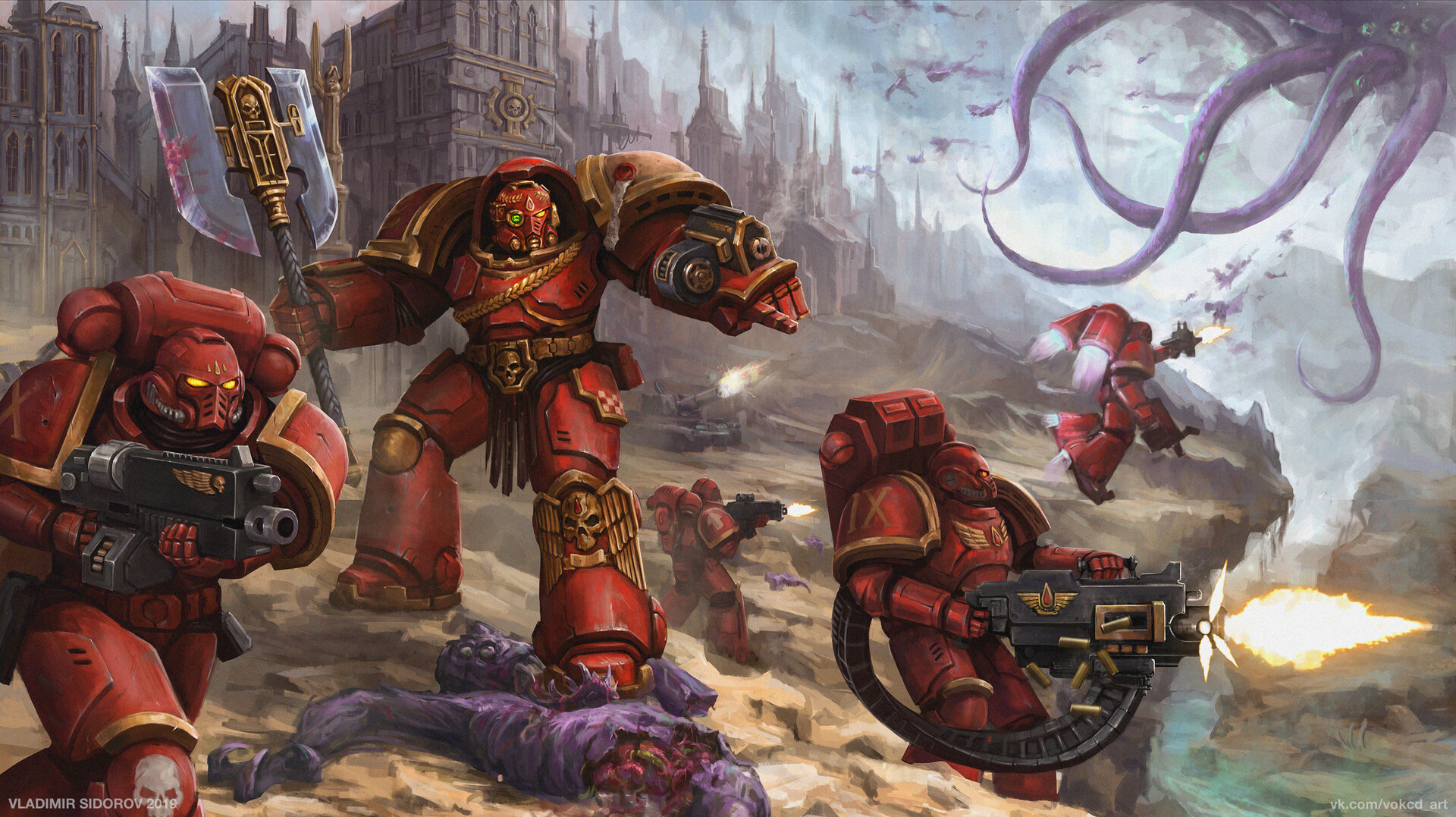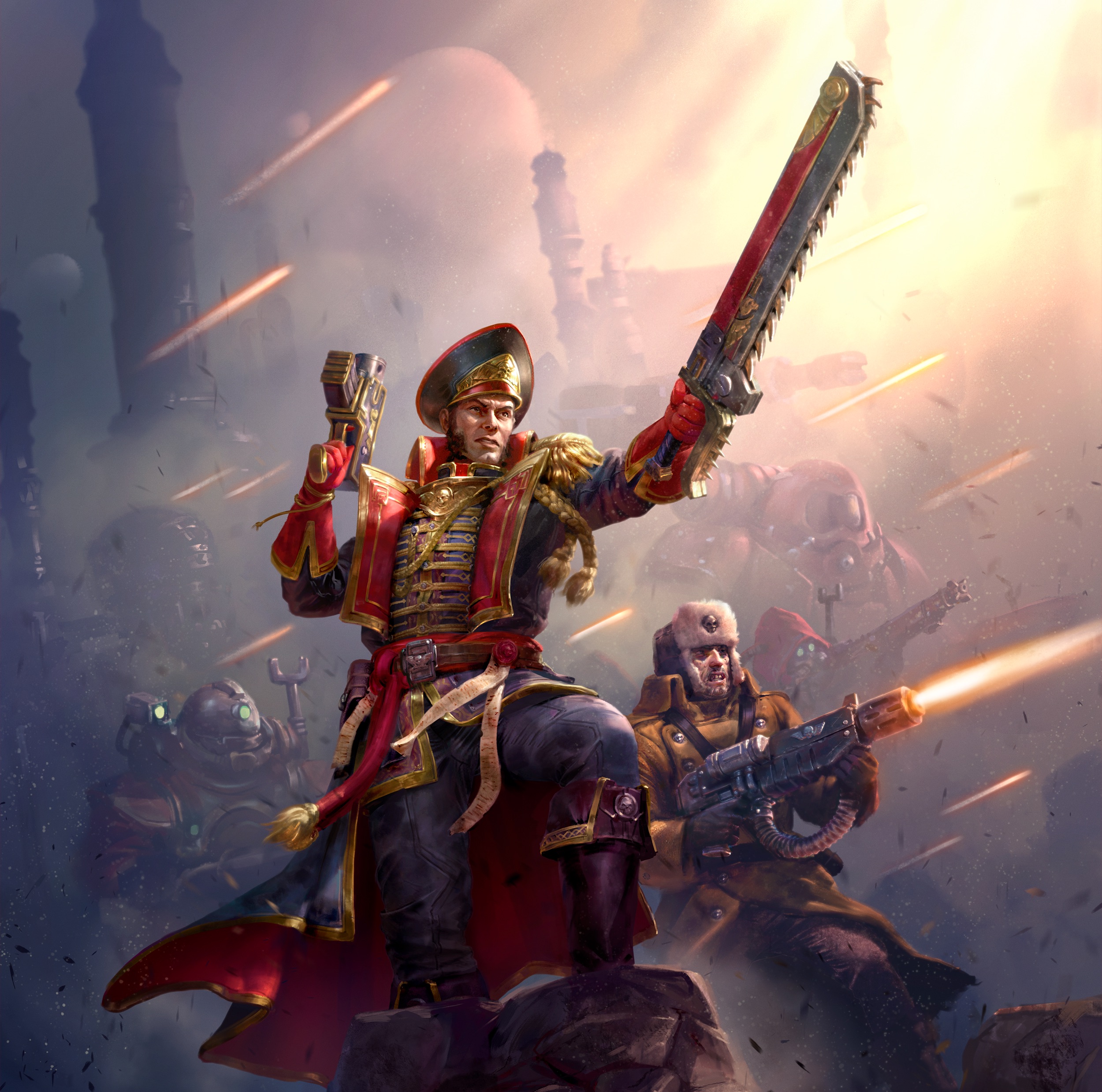Introduction
The Warp – also known as the Immaterium, Empyrean, or Realm of Chaos – is an alternate dimension of purely psychic energy that exists parallel to the physical universe. It is often called Warpspace or the Sea of Souls, reflecting its ethereal nature.
The Warp echoes and underlies realspace, meaning it touches every corner of the galaxy even though it cannot be seen or measured with normal instruments. This mysterious realm is utterly unlike the material world: it is the source of all psychic powers and sorcery, and it is the home of powerful malevolent entities – the Chaos Gods and their daemonic servants.
Humanity depends on the Warp for vital things like faster-than-light travel and astrotelepathic communication, making it essential to galactic civilization. Yet the Warp is incredibly dangerous. It is chaotic, unpredictable, and inhabited by nightmarish beings that wish harm upon mortals.
Imperial scholars and Navigators grimly note that the Warp is humanity’s greatest double-edged sword – “our greatest gift, and also our greatest threat”. In the grim darkness of the far future, the Warp stands as both a necessary tool and an ever-present menace, a swirling ocean of souls that offers hope of salvation even as it threatens eternal damnation.
The Nature of the Warp
The Warp is a chaotic, fluid realm where ordinary physical laws do not apply. It is often described as a churning sea of raw emotion and psychic energy, a reflective shadow of the material universe shaped by the thoughts, feelings, and souls of every living being. Joy, hate, fear, ambition – every emotion ripples through the Immaterium, influencing its tides.
In essence, the Warp feeds on and mirrors emotions: it is “born from the thoughts, dreams, and emotions of every psychically attuned sentient race”, and every act of hope or hatred in realspace strengthens corresponding energies in the Warp.
Because it is composed of thought-stuff and emotion, the Warp has no fixed form or geography. It is formless and ever-changing – a stormy expanse where space and time themselves are distorted. Distance and duration lose meaning in this domain; the laws of nature flicker and shift, making the Warp a place where reality is subjective and time flows inconsistently.
Mortals who peer into the Warp often perceive only madness: the Immaterium can “never be perceived or understood except through symbols and subjective interpretation”. In other words, a human mind can only grasp the Warp’s alien reality by seeing illusory shapes or visions that their psyche invents as a coping mechanism.
One moment the Warp might appear as a swirling rainbow of light, and the next as a hellish landscape of screaming faces – both are metaphors for a truth too bizarre to comprehend. This instability is why the Warp is so unpredictable. Like an ocean in constant tempest, it has currents, eddies, and storms that change with no rhyme or reason. A calm region can suddenly erupt into a maelstrom if fed by a surge of war and bloodshed in the material world, only to subside just as quickly. In short, the Warp is chaos incarnate – a realm where emotion becomes reality, and reality behaves like a nightmare.
Warp Travel
Despite its perils, the Warp is absolutely essential for space travel in Warhammer 40K. Because no spacecraft can normally exceed the speed of light in realspace, the Imperium of Man (and other starfaring races) rely on the Immaterium to journey between stars.
Starships are equipped with Warp-Drives that tear open a temporary portal, allowing the vessel to “enter the Warp” and leave the material universe behind. Once inside this parallel dimension, the ship is carried along by the Warp’s currents like a ship on a stormy sea, moving far faster (relative to realspace) than any engine could propel it in normal space.
After sailing the Immaterium for a calculated time, the ship’s Warp-Drive activates again to translate back into realspace, re-emerging many light years from its start point. In this way, a voyage that would take centuries using sublight travel might only take weeks or days via the Warp.
This method of faster-than-light travel is often called a Warp jump. It is the only reason humanity is united in a vast Imperium – as one Imperial source puts it, “By such fragile means, humanity is bound together in a single Imperium. The Emperor’s will may be mighty, but his reach is long only because Warpspace may be crossed by his fleets.” Without the Warp, interstellar empire would be virtually impossible.
Navigating through the Warp is an immensely difficult task. The Immaterium has no landmarks or fixed directions – a ship in Warp is essentially blind, adrift in a roiling sea of energy. To steer a course, the Imperium relies on two critical aids.
The first is the Astronomican, a psychic beacon projected through the Warp by the Emperor of Mankind on Terra (Earth). Fueled by the sacrificed souls of a thousand psykers whose life force is spent to sustain it, the Astronomican is like a lighthouse in the Sea of Souls. It emits a powerful guiding signal that psychic Navigators can detect and use as a reference point for navigation.
This leads to the second aid: the Navigator themselves – a specialized mutant with the unique ability to perceive the Warp. Navigators are born with a third eye (the Warp Eye) that allows them to gaze into the Immaterium without going insane. They can psychically “see” the Astronomican’s beam and the flow of Warp currents, steering the ship along a safer route. Thanks to Navigators, Imperial ships can undertake long Warp passages of many light years, making course corrections mid-journey instead of being limited to short blind jumps.
Even with these advantages, Warp travel is fraught with danger. The Immaterium’s currents are erratic – a vessel may arrive wildly off-course if the Navigator miscalculates or if a disturbance throws the ship astray. Time itself is unreliable in Warp: days might pass on the ship while years pass in realspace, or vice versa.
For example, a voyage that feels like mere hours to the crew could equate to weeks back home. There are instances of ships emerging from the Warp to find that centuries have gone by in the outside universe, or rare tales of vessels that arrive before they departed due to bizarre temporal loops. This time distortion makes every Warp jump a gamble, as no crew can be entirely sure how long their trip will be in realspace terms.
Yet an even greater peril lurks in the Warp’s very nature: it is infested with predatory entities. To travel safely, ships must activate a Gellar Field, a protective energy bubble that envelops the vessel in transit. The Gellar Field essentially carries a “bubble” of realspace around the ship, keeping out the hostile environment and creatures of the Warp. If this shield falters, the results are horrifying – unprotected ships are quickly invaded by daemons or torn apart by Warp energies.
Imperial crews know that a Gellar Field failure means a fate worse than death; as one account notes, without this shield the crew would be “at the mercy of all of these horrors” and likely be devoured or possessed by Daemons.
Additionally, random Warp turbulence (such as Warp storms) can seize a ship and fling it wildly off course, or trap it in the Warp indefinitely. For all these reasons, Warp travel is never taken lightly. Each jump is a venture into a lethal, otherworldly realm – a necessary plunge into hell so that humanity may reach the stars.
Psychic Powers and the Warp
In Warhammer 40K, all psychic powers – from telepathy and telekinesis to prophecy or destructive “witchfire” – originate from the Warp. A person with such abilities is called a psyker, and they are essentially tapping into the energy of the Immaterium to achieve supernatural effects. The Warp is often described as the wellspring of sorcery and magic.
In scientific terms, a psyker’s mind acts as a channel or conduit to the Warp, drawing on its endless power and shaping it with their will. When a sanctioned Imperial psyker hurls a lightning bolt or an Eldar Seer scryes the future, they are reaching into the Immaterium and bending its raw energy to affect reality.
As the lore explains, “the strange powers of psykers of all kinds flow from the power of the Warp, the psyker’s mind acting as a channel for the unreality of the Warp to affect reality.” In essence, the Warp is the source of all psychic phenomena – it is a universal ocean of power that gifted individuals (or warp-tainted sorcerers) can tap into, like drawing water from a deadly well.
However, harnessing the Warp’s power is an extremely perilous endeavor. Psykers risk their minds, souls, and lives every time they reach into that sea of souls. The act of using psychic powers is not a neutral, safe process – it is literally opening a door for Warp influence to spill into the material world.
If a psyker is not strong-willed enough or properly trained, that door can swing both ways, allowing something horrific to reach back through the veil. Foremost among these dangers is daemonic possession. Malevolent entities lurk in the Warp, hungry for a chance to enter realspace, and an active psyker is like a bright beacon to them.
A moment of weakness, distraction, or overextension by the psyker can invite a daemon to force its way into the psyker’s mind and body. Unprotected human psykers are particularly vulnerable to being possessed by Warp entities or having their souls consumed, which is why the Emperor of Mankind imposed strict controls on human psychic use. In fact, during the Imperium’s early days, the Emperor outright banned most unauthorised psykers, knowing that “most human psykers always run a substantial risk of being possessed by the Daemonic entities of the Warp”, which could lead to untold death and destruction.
The Imperium’s grim history justifies this fear: in past eras (such as the Dark Age of Technology and the ensuing Age of Strife), countless worlds were ravaged or lost entirely due to uncontrolled psykers whose minds unleashed Warp horrors upon humanity. These catastrophic events – where entire planets fell to demonic incursion or psychic calamity – illustrate the worst-case scenario of what the Warp can do if a psyker fails to contain it.
Even short of possession, psykers must contend with “Perils of the Warp”, a term encompassing the unpredictable psychic backlashes and phenomena that occur when channeling Warp energy. A psyker who pushes their power too far might inadvertently tear a small hole to the Warp, causing reality to flicker or otherworldly howls to emanate from thin air.
They might suffer brain-bursting feedback, summon a lesser daemon by accident, or be driven insane by a whisper from the abyss. Every use of Warp power is a risk – a delicate balance between harnessing the Warp and not inviting its wrath.
Because of these dangers, human psykers in the Imperium undergo rigorous training and mental conditioning (if they are allowed to live at all), and many carry wards or employ protective rituals. The Aeldari (Eldar), an ancient psychic race, have their own elaborate safeguards when using the Warp, and even they are not immune to its dangers.
Thus, psychic powers in Warhammer 40K are a classic double-edged sword granted by the Warp: they offer incredible abilities that can turn the tide of war or enable communication across the galaxy, but at any moment they could also doom the psyker and everyone around them to a fate worse than death.
Chaos and the Ruinous Powers
The Warp is not only a sea of mindless energy – over time it has spawned its own gods. In the Warhammer lore, the most powerful and infamous entities of the Immaterium are the four great Chaos Gods, also called the Ruinous Powers.
These dark gods are actually born from the emotions of mortal beings. In the primordial epochs of the galaxy, as sentient species grew in number and their collective feelings intensified, the formless psychic energy of the Warp began to coalesce into distinct consciousnesses.
Rage, despair, ambition, excess – the extreme peaks of emotion in the material realm gradually gave shape to beings in the Immaterium. Eventually, these psychic entities became self-aware and independent of the ebb and flow of mortal emotion, effectively becoming gods within the Warp.
Over millennia, four immense powers emerged, each an immortal embodiment of particular emotions and impulses. These are the four Chaos Gods, eternally hungry for the emotions that birthed them and perpetually influencing the galaxy toward their own dark ends.
The Chaos Gods and their natures are:
Khorne
The Blood God, Lord of Battle and Rage. Khorne epitomizes anger, hatred, and violence. Every act of war and murder in the galaxy feeds Khorne’s strength. He cares only for bloodshed and martial honor, and his realm within the Warp is built on anger and bloodletting – battlefields littered with skulls and rivers of blood.
Tzeentch
The Changer of Ways, Master of Sorcery and Schemes. Tzeentch personifies change, ambition, hope, and cunning. He is fed by the desire for evolution and knowledge. All acts of conspiracy or quest for forbidden lore please Tzeentch. His dominion is a twisted maze of arcane magic and constantly-shifting architecture – a reflection of his love for mutation and intrigue.
Nurgle
The Plague Lord, God of Decay and Rebirth. Nurgle embodies despair, morbidity, and the acceptance of mortality. He is empowered by fear of death and the defiant emotional response of hopelessness turned to dark comfort. Pandemic diseases, rot and renewal are Nurgle’s gifts. His Warp domain is a garden of corruption and life in decay, a haven of ever-festering death that paradoxically breeds new life (in the form of parasites and disease).
Slaanesh
The Dark Prince, Lord of Excess and Pleasure. Slaanesh represents desire, obsession, indulgence, and pain given form. Born from the collapse of the Eldar’s hedonistic empire, Slaanesh thrives on excesses of sensation and experience – every act of selfish pleasure or sadistic pain feeds this god. Slaanesh’s realm is an alluring paradise of damning temptations, filled with grand halls of sensual delights that mask an eternity of corruption.
Each of these four gods is a vast, immortal intelligence in the Warp, and each rules over a personal sub-realm within the Immaterium (often called the Realm of Chaos). They are in a sense the ultimate personifications of Chaos, since they were literally birthed by chaotic emotions.
Mortals often refer to them as the Ruinous Powers because everything they touch leads to ruin. These dark gods constantly vie with each other in the Warp in an endless power struggle known as the Great Game, but they are just as likely to unite against the material universe they hate.
The Chaos Gods hunger for the souls and emotions of mortals; they seek to corrupt the galaxy to serve them. They can stir up wars and disasters in realspace to generate more of the emotions that empower them (for instance, Khorne exults in every massive war, while Nurgle revels in plagues that spread despair).
Notably, the Chaos Gods can influence mortals subtly through dreams and whispers, turning individuals into Chaos cultists or corrupting entire civilizations over time. In fact, each Chaos God has mortal followers and cults devoted to them, as well as corrupted legions of traitor Space Marines (the Chaos Space Marines) who serve their will.
The Warp itself is often simply called “Chaos” because of the dominion of these Ruinous Powers. To those living in the Imperium, the Chaos Gods are the ultimate cosmic horrors – vast, malevolent deities spawned from humanity’s own sin and emotion, eternally thirsting for dominion over realspace.
Daemons and the Entities of the Warp
The Chaos Gods are not solitary in the Immaterium. The Warp is teeming with other entities and life-forms, all born of its psychic substance. The most infamous of these are the daemons – creatures of the Warp that serve (and are created by) the Chaos Gods.
In truth, the Imperium uses the term “daemon” (or demon) to refer to any hostile Warp entity, but in the strictest sense a daemon is an extension of a Chaos God’s power given individual form. The Chaos Gods create servants from their own essence, shedding fragments of their nearly limitless energy to spawn lesser beings that carry out their will. “A Daemon is ‘born’ when a Chaos God expends a portion of its own power to create a separate being,” binding together a collection of thoughts and purpose into a distinct consciousness.
These servants are the myriad Daemonettes, Bloodletters, Plaguebearers, Horrors and countless other kinds of daemonic creatures that populate Chaos lore. Every daemon is tied to the nature of its patron god – for example, Khorne’s daemons are bestial embodiments of wrath and slaughter, while Tzeentch’s daemons are bizarre, sorcerous entities reflecting change and trickery.
Daemons have personalities (often simplistic and single-minded, driven by the aspect of Chaos they represent), and they form legions and armies within the Warp, eternally fighting in their gods’ wars. However, they are not truly independent beings. A daemon is essentially a piece of its creator; a Chaos God can reclaim the power invested in any of its daemons at will, unmaking the creature instantly.
This ensures daemons remain loyal – they are literally extensions of the god’s will – and it means that killing a daemon is temporary at best. When a daemon is defeated, its energy disperses back into the Warp and eventually reforms, or the Chaos God reconstitutes it, since only the “loss of that [divine] power” permanently destroys a daemon’s essence.
Daemons (and other Warp entities) are fundamentally creatures of psychic energy, not flesh and blood. In the Immaterium, they don’t have physical bodies as we understand them. The very concept of “matter” or biology is meaningless in that dimension.
Instead, a daemon in the Warp is a collection of emotions and thoughts shaped into a self-aware force. They appear to one another – and to psykers who glimpse the Warp – in various horrifying guises, but these forms are mutable and often symbolic. Within the Warp, daemons exist as swirling intelligences that can adopt whatever form suits their nature or the fears of those perceiving them.
When a daemon manages to manifest in realspace, it essentially condenses a body out of Warp energy. This body is a psychic construct rather than true flesh – it might look solid (and can certainly kill you just like a real monster), but it is sustained by the power of the Warp and will eventually disintegrate if that connection is severed.
Daemons usually enter the physical universe only through special circumstances that weaken the boundary between worlds. This can happen when a psyker unwittingly summons or invites a daemon during a miscast. It can also occur on battlefields soaked in death and despair (strong emotions can tear open a Warp rift), or in places corrupted by Chaos cult rituals. Most dramatically, daemonic legions pour into realspace during events like Warp storms or Warp rifts (discussed below), when the veil between dimensions is torn open.
When a daemon crosses into reality, it is a terrifying event. These entities defy natural law – some shrug off normal weapons unless those weapons are blessed or made of psychic energy. Daemons often exhibit unnatural abilities: teleportation, conjuring hellfire, instilling terror with an aura of pure dread, etc.
Yet they are not invincible. If you “kill” a daemon’s corporeal form, you banish it back to the Warp, buying only temporary respite. Daemons cannot remain in the mortal world indefinitely unless the Warp’s energy is strongly present (for instance, in a Chaos-saturated region like the Eye of Terror). Many will dissipate after a few hours or days, or even minutes, if the warp rift sustaining them closes. Still, the damage they inflict in that time can be catastrophic.
Aside from daemons, the Warp hosts other strange beings – some are lesser predators, like psychic parasites that prey on unshielded psykers, and others are neutral or unknown entities with their own alien agendas. The Imperium tends to label any and all of these as “daemons” or “Warp entities” and treats them as threats. To human eyes, a floating predatory Warp-spirit or an Enslaver (a body-snatching warp creature) is just as demonic as a Bloodletter of Khorne.
In summary, daemons are the denizens of the Warp, birthed from its chaos and often instruments of the Chaos Gods. They are nightmares incarnate – literally the stuff of fear and hate – and whenever they intrude upon the material universe, they bring mankind’s worst fears to life.
The Perils of the Warp
For all its usefulness, the Warp is fundamentally hostile and dangerous to mortals. Numerous horrors fall under the “Perils of the Warp,” from random cosmic phenomena to deliberate demonic onslaughts.
One of the greatest dangers are Warp Storms – massive, turbulent disturbances in the Warp that can span vast distances. A Warp Storm is like a psychic hurricane that rages through the Immaterium, often spilling over to wreak havoc in realspace.
These storms have “incomprehensibly destructive fury” and can last anywhere from days to centuries. When a Warp storm occurs, it scrambles Warp travel and communication in the affected region. Ships cannot safely enter Warp near a storm (they’d be torn apart or lost), and astropathic messages fail to get through the Warp’s turmoil.
Thus, Warp storms can isolate entire star systems or sectors, cutting them off from the rest of the galaxy for years at a time. In the Age of Strife (Millennia before the Imperium), Warp storms raged so intensely across the galaxy that human worlds were severed from one another for generations, leading to a long dark age of anarchy.
Warp storms are unpredictable – they can appear and dissipate seemingly at random, or move in erratic paths. Some are caused by specific events (for example, massive outpourings of emotion or genocide might trigger a storm in the Warp), while others have no apparent trigger and are thought to be natural upheavals of that chaotic realm.
Particularly powerful Warp storms can even breach the boundary between Warp and realspace. In such cases, reality itself is warped by the storm: unholy energies spill out, sometimes creating temporary portals where daemons flood into the physical world. Lights in the sky, sanity-shattering hallucinations, and other paranormal phenomena accompany these Warp-tempests.
Rarely, a Warp storm becomes permanent, essentially tearing a hole in the fabric of reality that never fully closes. These persistent trans-dimensional breaches are known as Warp Rifts or Warp tears. The most infamous example is the Eye of Terror – a colossal Warp rift on the galactic west, near the Imperium’s Segmentum Obscurus.
The Eye of Terror was created over ten thousand years ago during a cataclysmic event: the Fall of the Eldar. When the Eldar empire’s debauchery gave birth to the Chaos God Slaanesh, the psychic shockwave “permanently breached the veil between realspace and the Warp” in that region.
The result was a gigantic Warp storm that swallowed hundreds of star systems, pulling them into the Immaterium. Those worlds were instantly saturated with Warp energy, becoming twisted Daemon Worlds under the sway of Chaos.
To this day (41st millennium and beyond), the Eye of Terror remains the largest and deadliest Warp rift in the galaxy – a hellish overlap of the Warp and realspace. It appears in the night sky as a vast, gaping purple-red scar, visible from countless Imperial planets as a baleful bruise on the stars. Within the Eye, the normal rules of reality don’t apply; it is essentially a corner of the galaxy claimed entirely by the Warp.
This region serves as a literal beachhead for Chaos in the material universe: the Traitor Legions of Chaos Space Marines have made their strongholds inside the Eye of Terror, and from its depths they launch Black Crusades and incursions into the Imperium.
The Eye of Terror is a permanent reminder of how terrifying the Warp’s presence can become if unleashed. (In recent lore, a catastrophic event known as the Great Rift has opened even more such tears across the galaxy, dividing the Imperium in half – but that is a subject for another time. Suffice to say, the galaxy’s situation has only gotten more dire as Warp rifts multiply.)
Aside from grand phenomena like storms and rifts, the Warp presents direct dangers to individuals and planets. Daemonic incursions are one such peril – this is when Warp entities manage to invade realspace, either through a rift or by possession/corruption. A daemon outbreak on a world can lead to demonic horrors running rampant, slaughtering and corrupting everything they find.
Sometimes an entire army of daemons spills out (often heralding a Chaos invasion by the forces of Chaos Marines or cultists that follow). These incursions can turn a thriving hive city into a charnel house overnight, as daemons butcher the population or enslave them in orgies of Chaos. The aftermath is usually a tainted, haunted location; even if the daemons vanish, the area might remain corrupted by the Warp.
Warp corruption is another insidious danger: prolonged exposure to Warp energies can mutate living beings and contaminate environments. Victims of Warp corruption may develop grotesque physical mutations (extra limbs, unnatural strength, warped minds) or fall under the mental domination of a Chaos entity.
Entire planets near a Warp rift can become so twisted that they are known as Daemon Worlds, where reality is distorted and mortal inhabitants degenerate into monsters. For example, worlds bordering the Great Rift or Eye of Terror often suffer this fate – some experience bizarre time flow, others are bombarded by demonic phenomena, and many are “so corrupted that they are now labelled as Daemon Worlds” by the Imperium. Even without a full-scale incursion, Warp taint can seep through thin spots in reality. Haunted locales, possessions, madness – these can all result from a minor Warp bleed or a psyker gone out of control.
Finally, one cannot forget the personal peril for any traveler or psyker who directly encounters the Warp. As mentioned earlier, a ship in Warp must be shielded; if a traveler were to look outside the Gellar Field, they could be driven irrevocably insane by what they see.
The Warp preys on one’s deepest fears and amplifies them. Many a voidship crew has legends of the things scratching at the hull during Warp passage, or the whispers that slither into the mind in the dark between stars. Most humans wisely choose ignorance – they travel through the Warp asleep in their bunks, trusting the Navigator and machine-spirits to get them through.
Those who are overly curious about the Warp’s true nature risk damning their soul. In summary, the Warp’s perils range from natural disasters (tempests in space-time) to active predators (daemons and corrupting forces). It is a dimension where reality and nightmare meld, and whenever that spills into our universe, horror follows.
The Imperium has endured Warp storms that isolate and starve worlds, daemon invasions that exterminate whole sectors, and spreading corruptions that turn loyal citizens into mutant traitors. It is no wonder that humanity at large views the Warp with superstitious terror – and why the Imperium exercises such brutal measures to guard against its threats.
The Imperium’s War Against the Warp
Given the innumerable dangers posed by the Warp and its denizens, the Imperium of Man wages a constant war to contain and control the Warp’s influence. This is not a traditional war with battlefronts (though battles with daemons certainly occur); rather, it is an ongoing effort at all levels of Imperial society to defend humanity from Chaos corruption, daemonic incursion, and psychic catastrophe. Several organizations and methods are dedicated to this cause:
The Adeptus Astra Telepathica (and the Soul Binding)
This is the Imperial institution responsible for the management of psykers. Psykers are both a valuable resource and a potential ticking time bomb of Warp danger. The Adeptus Astra Telepathica operates the dreaded Black Ships – a fleet of black-hulled vessels that traverse the Imperium collecting psykers from every world. These Black Ships gather thousands of psykers each year, taken from local populations (often witches, unsanctioned psykers, or identified psyker children).
Aboard the Black Ships, these captives are kept in psychic null-cells and brought to Terra for assessment. The Telepathica’s goal is to find those psykers strong and stable enough to serve the Imperium, while the rest – the majority – are executed or sacrificed so they cannot become gateways for demonic forces.
On Terra, the surviving psykers are trained and indoctrinated in the Scholastica Psykana, the Telepathica’s training division. Those who pass rigorous testing become Sanctioned Psykers – approved to serve in the Imperial Guard or other roles – or are made into Astropaths (telepathic communicators).
A critical ritual known as Soul Binding is performed on astropaths: the psyker acolytes are brought before the Golden Throne to be soul-bound to the Emperor’s own immense psychic presence. This ritual bolsters their minds with a fragment of the Emperor’s will, granting them some protection from Warp predation (and enhancing their telepathy) at the cost of their sight and often some of their sanity.
By soul-binding and training, the Imperium arms its psykers with defenses against the Warp. Even so, their lives are dangerous; many sanctioned psykers still fall victim to “perils of the Warp” in service, and Imperial Guard superiors are known to execute their own psyker allies at the first sign of demonic taint to prevent disaster.
The Adeptus Astra Telepathica’s work is grim but vital – without it, human psykers would run rampant and the Imperium would quickly be overrun by Warp incursions from within. (It’s worth noting that the Emperor himself must be fed a soul-draining diet of psyker lives to sustain his existence and the Astronomican – another horrific but necessary facet of the Imperium’s relationship with the Warp.)
The Inquisition (Ordo Hereticus and Ordo Malleus)
The Inquisition is a secretive Imperial organization with virtually unlimited authority to combat internal threats to humanity. Two of its branches are specifically focused on Warp-related dangers.
The Ordo Hereticus, sometimes called Witch Hunters, deals with rogue psykers, witches, and Chaos cults lurking within human society. They investigate rumors of demonic possession, sorcery, or unlicensed psykers, and they exterminate these threats ruthlessly.
The Ordo Malleus, also known as Daemonhunters, is the oldest branch of the Inquisition and is devoted to combating daemons and Chaos incursions directly. Inquisitors of the Ordo Malleus are among the few sanctioned individuals in the Imperium who deeply study the Warp’s adversaries so they can better destroy them. They have access to forbidden knowledge and exotic weaponry (like wards, daemon-weapons, etc.) for facing Chaos.
The Inquisition’s war against the Warp is fought in the shadows: they operate through investigation, interrogation, and swift destruction. An Inquisitor has the authority to declare Exterminatus – the complete annihilation of a planet – if a world is too far gone in demonic possession or Chaos corruption. This is not done lightly, but it has been done to contain daemonic outbreaks at the source.
The Inquisition also practices extreme censorship and secrecy regarding Chaos. For most citizens of the Imperium, the existence of Chaos or daemons is not common knowledge (they may only know vague mythology). This is by design: “To protect its citizens from the insidious temptations of Chaos, the Imperium long did its best to hide the existence of the Chaos Gods and Daemons from public knowledge.”
Simply knowing about Chaos is seen as a risk, for knowledge can breed curiosity or despair that leads to heresy. Thus, when a daemon manifests and is defeated, Inquisitors often mind-wipe or eliminate any witnesses, even Imperial Guardsmen who fought bravely, to ensure no seed of corruption remains. They will purge records and even entire organizations if needed to snuff out Chaos’s taint.
The lengths the Inquisition goes to are extreme – for instance, it was policy to erase the memories of even Space Marines who encountered Chaos, and only since the recent galaxy-wide Chaos upheavals (the Great Rift) has the Imperium relented slightly on keeping the Astartes in ignorance.
In short, the Inquisition is the shield and dagger in the dark, hunting any sign of Warp corruption within humanity and excising it with brutal finality. Their motto might as well be “suffer not the daemon (or witch) to live.”
The Grey Knights
Where the Inquisition provides the clandestine investigators and judges against Chaos, the Grey Knights provide the ultimate warriors to confront Warp threats. The Grey Knights are an elite Chapter of Space Marines, unique in that their entire number are psykers and demon-hunters.
They were created in absolute secrecy during the Horus Heresy as a specialized force to fight daemons, and they serve as the Chamber Militant of the Ordo Malleus (the Inquisition’s daemon-hunting arm). Grey Knights undergo the most rigorous psychic training and spiritual fortification imaginable.
Their gene-seed (genetic implant material) was derived from the Emperor himself, and they are said to be psychically blessed by the Emperor’s light. As a result, Grey Knights are famously incorruptible: in over ten millennia of warfare, “no Grey Knight has ever been corrupted by the Ruinous Powers of Chaos”.
This is practically a miracle in 40K, where corruption is rife even among the mighty. Each Grey Knight is armed with consecrated weapons (such as Nemesis force weapons) and wears power armor inscribed with prayers and hexagrammic wards. They not only battle the toughest daemons in direct combat, but also use their psychic abilities collectively to banish demons and shield themselves and allies from Warp sorcery.
The Grey Knights operate from a hidden base on Titan (one of Saturn’s moons), and their operations are top-secret; often the mere presence of Grey Knights on a battlefield will lead to the Inquisition wiping all knowledge of the event from surviving Imperial forces.
The Grey Knights are few in number (a Chapter of around a thousand active Astartes), so they deploy only for the most dire of Chaos threats – such as major daemonic incursions, Greater Daemons unleashed, or facing daemon primarchs and demigods of Chaos.
When they do appear, they are the Imperium’s best hope of containing a Warp disaster. For example, in lore, if a daemon prince or a greater daemon is rampaging on a world, the Grey Knights may teleport in, form a psychic choir to weaken the fiend with sacred rites, and strike it down where a normal army would stand no chance.
They have even ventured into the Warp itself on rare occasions to complete their missions. Alongside the Grey Knights, the Ordo Malleus can call on other assets like exorcists, daemon hosts (dangerous controlled daemons bound to service), or allied psykers – but the Grey Knights remain the pinnacle of Imperial demon-killing might, the Emperor’s purifying sword against the Warp’s worst monsters.
In addition to these organizations, the Imperium employs various other measures in its war against the Warp. The Sisters of Silence (also known as Null-Maidens) are an order of psychic “blanks” – humans with no presence in the Warp, whose very existence disrupts psychic phenomena. They often accompany the Inquisition or the Grey Knights to nullify enemy psykers and even weaken daemons (who recoil from the blank aura).
The Adeptus Mechanicus provides technology like psychic wards, inhibitor fields, and specialized munitions (e.g., psycannon bolts, hexagrammic wards on tank hulls) to help defend against Warp entities.
The Ecclesiarchy (Imperial church) encourages devout faith, which in the setting can manifest as a protective psychic phenomenon (the power of genuine faith can sometimes repel minor daemons, as the Emperor’s influence works through the faithful).
And of course, the existence of the God-Emperor on the Golden Throne is itself the lynchpin of humanity’s fight against the Warp: His daily battle in the psychic plane, His beacon (the Astronomican) lighting the Warp, and His status as an object of fervent faith all help guard humanity from total subjugation by Chaos. It is often said that the Emperor in his techno-sarcophagus is “the only thing standing between humanity and the howling madness of the Warp.”
The Imperium’s war against the Warp is endless and costly. Inquisitors burn entire cities to eradicate one cult; Black Ships haul away a world’s beloved children because they have latent powers; Grey Knights sacrifice themselves in doomed last stands to banish a greater daemon for a thousand years.
This is a war of grim necessity, fought in secret alleys and the depths of space, in the souls of human psykers and on the battlefields of demon worlds. The common citizen might live and die without ever knowing it occurred, thanks to the Imperium’s efforts to shield them from knowledge.
But despite all measures, the Warp can never be fully tamed or banished – at best, it is held at bay. The Imperium survives by maintaining this fragile equilibrium: using the Warp’s gifts enough to travel and communicate, but controlling its touch on humanity with an iron fist. Should that balance falter, Chaos would overwhelm mankind in an eye blink.
Conclusion
The Warp is the dark heart of Warhammer 40K’s cosmos – a place of both wonders and horrors that profoundly shapes the fate of the galaxy. It is difficult to overstate its importance: the Immaterium enables everything from star travel to psychic heroism, yet it is also the breeding ground of humanity’s worst enemies and fears.
This duality lies at the core of the setting’s grimdark tone. The Warp is a tool that makes the Imperium possible (binding countless worlds together through Warp jumps and astrotelepathy), but it is also a constant threat hanging over every human soul (for any warp voyage or psychic act might unleash annihilation).
In Warhammer 40K lore, nearly every major event has the Warp’s fingerprints on it – the rise of Chaos, the Fall of the Eldar, the Horus Heresy, the current massive Warp rift cleaving the galaxy, etc. It is a source of cosmic horror: an unknowable ocean of spirits and emotion that cares nothing for the logic or frailty of mortal life, and yet is intimately linked to mortal hearts and minds.
For a newcomer, the Warp can be imagined as both a hell and a lifeline – a realm of daemons and dark gods that would gladly devour humanity, but also the very sea on which humanity’s starships sail. This paradox is what gives Warhammer 40K much of its desperate atmosphere.
Mankind cannot abandon the Warp, for then it would stagnate and die in isolation; but by using the Warp, mankind forever dances on the edge of damnation. The Warp’s influence is felt everywhere: in every witch-burning and every prayer to the Emperor (who shields souls from the Warp), in every mutation cursed by a planetary governor, and every navigator gazing into the glowing madness to guide a ship. It is the literal and figurative shadow of the galaxy – sometimes called the Empyrean or the Sea of Souls – promising power, whispering secrets, and ready to consume the unwary.
In the grim darkness of the far future, the Warp remains as it has always been: a ravening abyss of possibility and terror. It is the backdrop for eternal war between Chaos and order, the medium through which gods and mortals alike contest their wills.
Those who would survive in the 41st Millennium must respect the Warp’s power and fear its capriciousness. To travel or to think a psychic thought is to brush against an infinite, living tempest. And as long as beings across the stars continue to feel emotion – to love, hate, dream, and despair – the Warp will continue to exist alongside reality, shaping destinies with its dark currents.
The Warp is, ultimately, both the key to humanity’s future and the instrument of its possible doom. It offers no easy answers, only the constant challenge: endure the storm, or be swallowed by it.
